Monday, 19 July 2010: Ypres, Flanders Fields
Written 22 July 2010
The Novotel offered two levels of breakfast: "regular" (the usual copious buffet) for 16 euros and "city" for 8 euros. The clerk told us the city breakfast was three small sandwiches and hot drink of your choice. Sounded fine, so Monday morning, I asked for the city breakfast and was shown to the bar area, where city breakfasters are asked to sit, apart from the buffet people. Did they have decaf? Yes, of course, or rather, no, the machine is broken. Tea, then. The "three small sandwiches" turned out to be two round hard rolls, two mini croissants, and two mini pains au chocolate—better than fine! Butter, even, on request.
Once David had also come down for a city breakfast, the two orders of business were (1) the In Flanders Fields Museum, in the old cloth hall on the Grande Place, and (2) laundry. So I gathered up my four skirts and two blouses and we set off for the museum. Having verified that my ticket would be good for multiple entries, all day long, so long as I wore my little red decal, David set off into the museum, and I peeled off toward the laundry service. I got there about 9:30 a.m., an hour and a half after opening time, and found nobody there. Drat. As I stood there, wondering what to do next, two other customers came and went, equally disgusted to find the fluff-and-fold service closed. A nice lady using the self-service machines indicated that she'd been there a while and had seen nobody. Why didn't I just wash the stuff myself by self-service? Our communication was a little sketchy, as she spoke only Dutch and Spanish, and I spoke only English and French, but she made clear that it would be perfectly safe to leave my stuff in a washer and come back later—she'd be there, anyway. As it happened, I still had a fist-full of the 50-eurocent pieces I'd acquired for tipping buskers in Ghent, so I had enough coins for both a packet of detergent from the vending machine and a cycle in the washer. The washers turned out to be much better ones than the incomprehensible and obsolete behemoths in Brittany in 2005. I was able to choose the temperature and cycle I wanted, and as soon as the machine started, it posted a digital countdown, so I knew how much later to come back.
 Back to the museum for a few minutes (this plaque marked it entrance, in the center of the huge cloth hall), then back to the laundromat to put the clothes in the dryer. The Spanish lady was leaving just as I arrived, but while I loaded the dryer, another lady (seeing my museum sticker, I guess) asked where I was from. She ran a bed and breakfast just across the street from the laundromat (she ran across to get me a business card and brochure) and was using the laudromat's big flat-bed pressing machine to iron a mountain of table linens. Her daughter had done a work-exchange program at Disney World two years earlier, so she and the rest of her family had visited Florida, driving from Orlando to Key West to St. Augustine. Back to the museum for half an hour, then back (again!) to the laudromat to pick up the dry clothes and take them back to the hotel. My feet were beginning to hurt again. The soles of my shoes were not quite thick enough to ease the strain of walking on the rough and uneven paving stones. I wasn't thrilled with putting the skirts through the dryer (at least it had a low-temp setting), and it didn't get all the spots out (I wasn't equipped to pretreat them as I do at home), but at least they're no longer stiff with dried sweat!
Back to the museum for a few minutes (this plaque marked it entrance, in the center of the huge cloth hall), then back to the laundromat to put the clothes in the dryer. The Spanish lady was leaving just as I arrived, but while I loaded the dryer, another lady (seeing my museum sticker, I guess) asked where I was from. She ran a bed and breakfast just across the street from the laundromat (she ran across to get me a business card and brochure) and was using the laudromat's big flat-bed pressing machine to iron a mountain of table linens. Her daughter had done a work-exchange program at Disney World two years earlier, so she and the rest of her family had visited Florida, driving from Orlando to Key West to St. Augustine. Back to the museum for half an hour, then back (again!) to the laudromat to pick up the dry clothes and take them back to the hotel. My feet were beginning to hurt again. The soles of my shoes were not quite thick enough to ease the strain of walking on the rough and uneven paving stones. I wasn't thrilled with putting the skirts through the dryer (at least it had a low-temp setting), and it didn't get all the spots out (I wasn't equipped to pretreat them as I do at home), but at least they're no longer stiff with dried sweat!
Written 24 July 2010
So I finally got back to the museum "to stay," as it were, and had time to finish seeing the small, introductory temporary exhibit before lunch. It documented the lives (and often deaths) of Chinese contract labor—thousands of young men—brought to Europe during WWI. They arrived in Belgium only after a sea voyage of 2-3 months in steerage conditions. According to the contract, they were entitle to food, housing, health care, and wages and were to be employed only outside combat zones. In practice, they often found themselves in harm's way, even well behind the trench lines, because the artillery barrages. As a group, they distinguished themselves by their cheerfulness, strong work ethic, and devotion to their mothers (which particularly impressed the locals). Each was known not by his name but by a five-digit contract number, so locals had only to learn the numbers 0-9 to be able to say all the names. A fair number were killed or wounded in the line of duty, many went home to China after the war, but quite a number settled down in Europe and married local girls. A short film included interviews with some of their European descendents, as well as with a little old Belgian lady (who has since died) who was a small girl at the time. She befriended two of the Chinese workers (who she referred to as her "Chinese papas") and met them on the road each day as they returned to their quarters from the work areas. Every day, they brought her back something—a flower, a pretty pebble, a toy one of them had made. The exhibit also included brass spent shell casing on which the Chinese workers, in their spare time, engraved text and pictures. We'd seen such items before, in France, engraved by the European soldiers, but of course the themes and style of these were much different. Some of the workmanship was gorgeous.

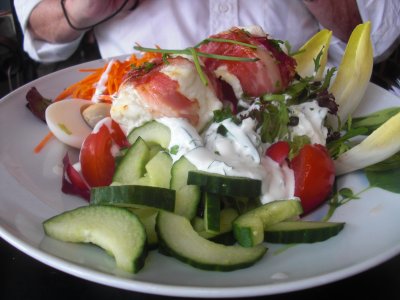 For lunch, we chose a café near the museum, within earshot of the shady arcade where a series of British school groups were doing outdoor concerts. Unfortunately, soon after our food arrived, they changed over from classical to rock music and got so loud that conversation was difficult. While we waited for our food, the waitress brought us a little crock of excellent pork rillettes (finely shredded seasoned braised pork bound with some pork fat) and garlic toasts to spread it on. David ordered the salad with goat cheese and got this huge heap (greens buried under piles of tomato, cucumber, carrot, cooked egg, witloof (Beldian endive) leaves, a creamy chive dressing, and two quarter-pound chunks of creamy goat cheese wrapped in bacon and broiled until soft. Excellent, but way too big.
For lunch, we chose a café near the museum, within earshot of the shady arcade where a series of British school groups were doing outdoor concerts. Unfortunately, soon after our food arrived, they changed over from classical to rock music and got so loud that conversation was difficult. While we waited for our food, the waitress brought us a little crock of excellent pork rillettes (finely shredded seasoned braised pork bound with some pork fat) and garlic toasts to spread it on. David ordered the salad with goat cheese and got this huge heap (greens buried under piles of tomato, cucumber, carrot, cooked egg, witloof (Beldian endive) leaves, a creamy chive dressing, and two quarter-pound chunks of creamy goat cheese wrapped in bacon and broiled until soft. Excellent, but way too big.
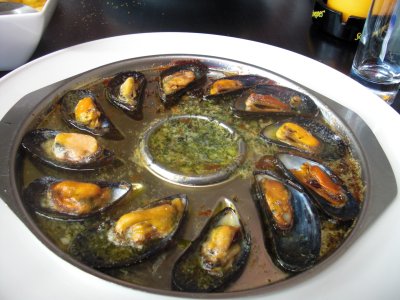 I tried something I'd never had before: mussels broiled ni garlic butter, as though they were snails. They came on the half shell, each shell nestled in a little tear-drop-shaped hollow in a metal platter designed for the purpose. Twelve mussels didn't seem like much, so I ordered fries to go with them but realized later I should have gotten bread instead, to soak up the delicious butter and juices. The fries were delicious but not very absorbent.
I tried something I'd never had before: mussels broiled ni garlic butter, as though they were snails. They came on the half shell, each shell nestled in a little tear-drop-shaped hollow in a metal platter designed for the purpose. Twelve mussels didn't seem like much, so I ordered fries to go with them but realized later I should have gotten bread instead, to soak up the delicious butter and juices. The fries were delicious but not very absorbent.
After lunch, it was back to the museum; David had covered less than half of it, and I had barely started the permanent exhibits. It was another of those where you "assume an identity" at the beginning and then, at various places in the museum you insert your little identity ticket to find out what "you" were doing at that time and place. I was, for some reason, Marie Curie, and I had already won the Nobel Prize by that time. My sister and I set up and ran diagnostic radiology clinics for the wounded from the front. We also encountered many electronic touch-screen stations where you could choose from a menu of topics. With each choice you were presented with one or more photos, a couple of paragraphs of text, and more choices, so you could go into as much depth as you wanted. The same readout was displayed on a second screen over your head for the benefit of those behind you. David immediately jumped on one he'd been trying all morning to get his turn on, then didn't move until we had thoroughly exhausted its entire (and extensive) repertory.
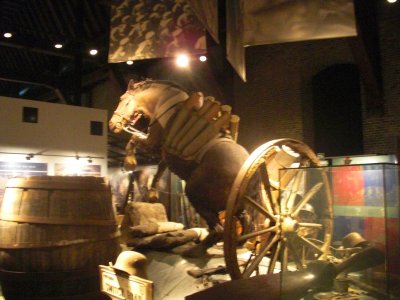 One of the most impressive display was this taxidermic tour de force, which you could walk all the way around, portraying a life size (real, actually) horse, matted and muddy and carrying a load of shells, sturggling up a bank, surrounded by the debris of a canon emplacement that has been blown up. As many horses as men were involved in WWI, and that's a lot (half a million men died at Ypres alone). Motorized transport had not really caught on yet, so all the heavy lifting was done by horses. That's why the Ardennes mountains were a serious barrier during WWI but why Hitler simply rolled over them in trucks 30 years later.
One of the most impressive display was this taxidermic tour de force, which you could walk all the way around, portraying a life size (real, actually) horse, matted and muddy and carrying a load of shells, sturggling up a bank, surrounded by the debris of a canon emplacement that has been blown up. As many horses as men were involved in WWI, and that's a lot (half a million men died at Ypres alone). Motorized transport had not really caught on yet, so all the heavy lifting was done by horses. That's why the Ardennes mountains were a serious barrier during WWI but why Hitler simply rolled over them in trucks 30 years later.
Hitler fought and was wounded in one of the battles of Ypres (of which there were three major, each several months long, and many minor). He visited it several times later on and greatly admired its reconstruction work (carried out with German reparation money), so during WWII, he ordered his armies not to enter it and not to pulverize it with artillery a second time. Instead, once it had been captured (the WWII lines swept past it in just two or three days), he visited it again several times and brought his architects along, so that they could study the reconstruction and take notes. He wanted to use Ypres as the pattern for the triumphal reconstruction of Germany after the war. I was surprised to see a photo of the ceremony marking the official end of the reconstruction of Ypres; it was taken in November of 1967, the fall that I was a freshman in college!
The single museum display I found most moving was a poem, both painted on the wall and read aloud by an actor, by a well-known WWI poet whose name escapes me at the moment. It describes his watching a comrade who, not being quick enough with his gas mask, died in agony among his fellows, who could do nothing to help him. "I saw him drowning, " . . . "the writhing of the eyes in his head," . . . If you could see what I have seen, "you would not tell with such high zest/To children ardent for some desperate glory,/The old Lie: Dulce et decorum est/Pro patria mori." [Note added later: The poet is Wilfred Owen, and the poem's title is "Dulce et Decorum Est," from the quote with which it ends—a Latin quotation that means "It is sweet and fitting to die for one's country." Read the full text at, e.g., http://www.english.emory.edu/LostPoets/Dulce.html.]
When our feet wouldn't take anymore, we went back to the hotel to change for dinner, this time at "Die Vier Konigen" (I'm not sure whether that's "four kings" or "four queens"—is "-en" a plural ending or a feminine one?—and the menus gave no clue, showing only the four suits and no face cards.
It was a good deal farther than Pacific Eiland, and much of the distance was along a busy highway rather than through a shaded park. When we finally got there, we found the restaurant entirely surrounded by road construction, fences, caution signs, etc., but a narrow path had been outlined by potted marigolds and paved with blue carpeting (over sheets of plywood) from the sidewalk to the door. We saw food go by on its way to other clients, but from where we were sitting, the place might have been empty except for us.
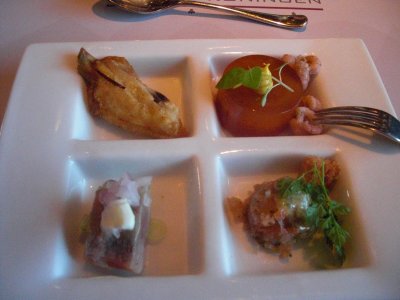
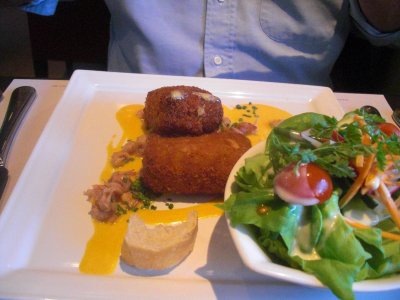 The amuse-bouche was fourfold—clockwise from the top left, a very tender crispy chicken wing, a timbale of gelled tomato soup with a dab of mustard on top (and sprinkled with tiny grey shrimp, as is apparently required by law around here), a mound of tuna tartare, and a slice of raw marinated "maatjes" herring (also in season just now). The soup was good, the other stuff better (though David didn't care for the herring).
The amuse-bouche was fourfold—clockwise from the top left, a very tender crispy chicken wing, a timbale of gelled tomato soup with a dab of mustard on top (and sprinkled with tiny grey shrimp, as is apparently required by law around here), a mound of tuna tartare, and a slice of raw marinated "maatjes" herring (also in season just now). The soup was good, the other stuff better (though David didn't care for the herring).
David's starter was shrimp croquettes, a very common Belgian dish that we had gotten around to trying yet. Very creamy inside but nothing to write home about and way too large for a starter.
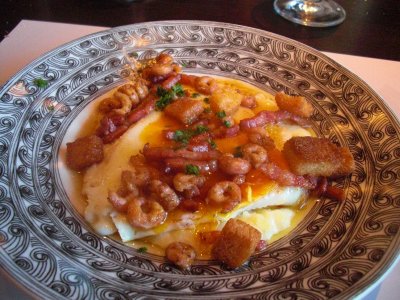
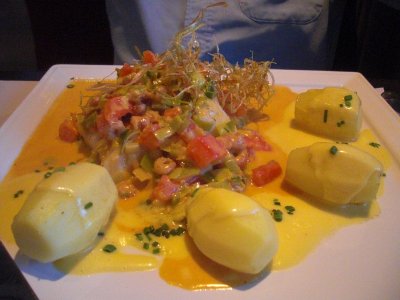 My starter was buttermilk potatoes topped with sunny-side-up eggs, shrimp, lardons, and croutons. What's not to like?! I was on that instantly. The croutons were good, but unfortunately, the potatoes were a little too sour and everything else was strangely tasteless.
My starter was buttermilk potatoes topped with sunny-side-up eggs, shrimp, lardons, and croutons. What's not to like?! I was on that instantly. The croutons were good, but unfortunately, the potatoes were a little too sour and everything else was strangely tasteless.
David's main course was lotte (monkfish) in a creamy leek sauce with tomatoes and shrimp and a thatch of frizzled leek shreds, surrounded by four whole steamed potatoes.
 I passed up braised pigs' cheeks "Grandmother style" for lambs' tongues (three of them, mistranslated into English as "veal tongues") Provençale, which came sprinkled with hard-cooked egg and accompanied by a large salad.
I passed up braised pigs' cheeks "Grandmother style" for lambs' tongues (three of them, mistranslated into English as "veal tongues") Provençale, which came sprinkled with hard-cooked egg and accompanied by a large salad.
The verdict all around? All of it should have been better than it was. The tongues were tender and delicious, but Provençale, is just not the right treatment for them, and the sauce partook a tad too much of the nature of Campbell's cream of tomato. We not only skipped dessert, we didn't even finish our main courses (I couldn't get through even two of the tongues). Hard to characterize what went wrong, other than that the starters were too large and that despite the good ingredients and theoretically interesting treatments, it just didn't gel into haute cuisine.
Discouraged and footsore, we took a cab back to the hotel.
previous entry
List of Entries
next entry
 Back to the museum for a few minutes (this plaque marked it entrance, in the center of the huge cloth hall), then back to the laundromat to put the clothes in the dryer. The Spanish lady was leaving just as I arrived, but while I loaded the dryer, another lady (seeing my museum sticker, I guess) asked where I was from. She ran a bed and breakfast just across the street from the laundromat (she ran across to get me a business card and brochure) and was using the laudromat's big flat-bed pressing machine to iron a mountain of table linens. Her daughter had done a work-exchange program at Disney World two years earlier, so she and the rest of her family had visited Florida, driving from Orlando to Key West to St. Augustine. Back to the museum for half an hour, then back (again!) to the laudromat to pick up the dry clothes and take them back to the hotel. My feet were beginning to hurt again. The soles of my shoes were not quite thick enough to ease the strain of walking on the rough and uneven paving stones. I wasn't thrilled with putting the skirts through the dryer (at least it had a low-temp setting), and it didn't get all the spots out (I wasn't equipped to pretreat them as I do at home), but at least they're no longer stiff with dried sweat!
Back to the museum for a few minutes (this plaque marked it entrance, in the center of the huge cloth hall), then back to the laundromat to put the clothes in the dryer. The Spanish lady was leaving just as I arrived, but while I loaded the dryer, another lady (seeing my museum sticker, I guess) asked where I was from. She ran a bed and breakfast just across the street from the laundromat (she ran across to get me a business card and brochure) and was using the laudromat's big flat-bed pressing machine to iron a mountain of table linens. Her daughter had done a work-exchange program at Disney World two years earlier, so she and the rest of her family had visited Florida, driving from Orlando to Key West to St. Augustine. Back to the museum for half an hour, then back (again!) to the laudromat to pick up the dry clothes and take them back to the hotel. My feet were beginning to hurt again. The soles of my shoes were not quite thick enough to ease the strain of walking on the rough and uneven paving stones. I wasn't thrilled with putting the skirts through the dryer (at least it had a low-temp setting), and it didn't get all the spots out (I wasn't equipped to pretreat them as I do at home), but at least they're no longer stiff with dried sweat!
 For lunch, we chose a café near the museum, within earshot of the shady arcade where a series of British school groups were doing outdoor concerts. Unfortunately, soon after our food arrived, they changed over from classical to rock music and got so loud that conversation was difficult. While we waited for our food, the waitress brought us a little crock of excellent pork rillettes (finely shredded seasoned braised pork bound with some pork fat) and garlic toasts to spread it on. David ordered the salad with goat cheese and got this huge heap (greens buried under piles of tomato, cucumber, carrot, cooked egg, witloof (Beldian endive) leaves, a creamy chive dressing, and two quarter-pound chunks of creamy goat cheese wrapped in bacon and broiled until soft. Excellent, but way too big.
For lunch, we chose a café near the museum, within earshot of the shady arcade where a series of British school groups were doing outdoor concerts. Unfortunately, soon after our food arrived, they changed over from classical to rock music and got so loud that conversation was difficult. While we waited for our food, the waitress brought us a little crock of excellent pork rillettes (finely shredded seasoned braised pork bound with some pork fat) and garlic toasts to spread it on. David ordered the salad with goat cheese and got this huge heap (greens buried under piles of tomato, cucumber, carrot, cooked egg, witloof (Beldian endive) leaves, a creamy chive dressing, and two quarter-pound chunks of creamy goat cheese wrapped in bacon and broiled until soft. Excellent, but way too big. I tried something I'd never had before: mussels broiled ni garlic butter, as though they were snails. They came on the half shell, each shell nestled in a little tear-drop-shaped hollow in a metal platter designed for the purpose. Twelve mussels didn't seem like much, so I ordered fries to go with them but realized later I should have gotten bread instead, to soak up the delicious butter and juices. The fries were delicious but not very absorbent.
I tried something I'd never had before: mussels broiled ni garlic butter, as though they were snails. They came on the half shell, each shell nestled in a little tear-drop-shaped hollow in a metal platter designed for the purpose. Twelve mussels didn't seem like much, so I ordered fries to go with them but realized later I should have gotten bread instead, to soak up the delicious butter and juices. The fries were delicious but not very absorbent. One of the most impressive display was this taxidermic tour de force, which you could walk all the way around, portraying a life size (real, actually) horse, matted and muddy and carrying a load of shells, sturggling up a bank, surrounded by the debris of a canon emplacement that has been blown up. As many horses as men were involved in WWI, and that's a lot (half a million men died at Ypres alone). Motorized transport had not really caught on yet, so all the heavy lifting was done by horses. That's why the Ardennes mountains were a serious barrier during WWI but why Hitler simply rolled over them in trucks 30 years later.
One of the most impressive display was this taxidermic tour de force, which you could walk all the way around, portraying a life size (real, actually) horse, matted and muddy and carrying a load of shells, sturggling up a bank, surrounded by the debris of a canon emplacement that has been blown up. As many horses as men were involved in WWI, and that's a lot (half a million men died at Ypres alone). Motorized transport had not really caught on yet, so all the heavy lifting was done by horses. That's why the Ardennes mountains were a serious barrier during WWI but why Hitler simply rolled over them in trucks 30 years later.
 The amuse-bouche was fourfold—clockwise from the top left, a very tender crispy chicken wing, a timbale of gelled tomato soup with a dab of mustard on top (and sprinkled with tiny grey shrimp, as is apparently required by law around here), a mound of tuna tartare, and a slice of raw marinated "maatjes" herring (also in season just now). The soup was good, the other stuff better (though David didn't care for the herring).
The amuse-bouche was fourfold—clockwise from the top left, a very tender crispy chicken wing, a timbale of gelled tomato soup with a dab of mustard on top (and sprinkled with tiny grey shrimp, as is apparently required by law around here), a mound of tuna tartare, and a slice of raw marinated "maatjes" herring (also in season just now). The soup was good, the other stuff better (though David didn't care for the herring).
 My starter was buttermilk potatoes topped with sunny-side-up eggs, shrimp, lardons, and croutons. What's not to like?! I was on that instantly. The croutons were good, but unfortunately, the potatoes were a little too sour and everything else was strangely tasteless.
My starter was buttermilk potatoes topped with sunny-side-up eggs, shrimp, lardons, and croutons. What's not to like?! I was on that instantly. The croutons were good, but unfortunately, the potatoes were a little too sour and everything else was strangely tasteless. I passed up braised pigs' cheeks "Grandmother style" for lambs' tongues (three of them, mistranslated into English as "veal tongues") Provençale, which came sprinkled with hard-cooked egg and accompanied by a large salad.
I passed up braised pigs' cheeks "Grandmother style" for lambs' tongues (three of them, mistranslated into English as "veal tongues") Provençale, which came sprinkled with hard-cooked egg and accompanied by a large salad.